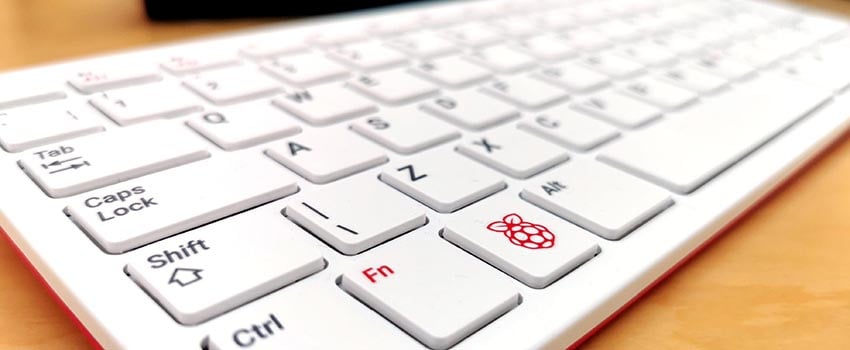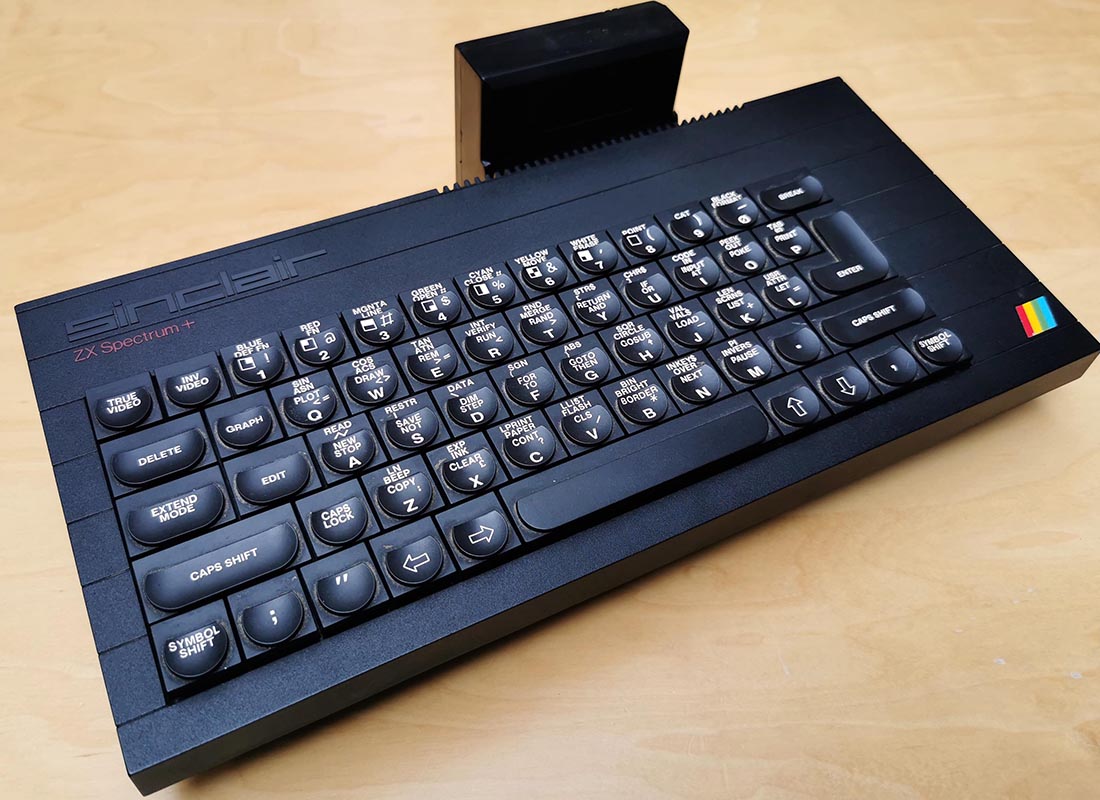As the Sinclair ZX Spectrum celebrates its 40th anniversary, we explore how you can relive your childhood computing experiences, writes Martin Cooper MBCS.
The Sinclair ZX Spectrum needs little introduction: the 8-bit home computer was launched on 23/4/1982 and went on to sell over five million units during its 10-year lifespan (that’s not counting the flotilla of fakes and unofficial derivatives which sprung up in different countries).
Why was the ZX Spectrum so popular?
In many ways the machine was, even for its time, unremarkable. Technically it was out gunned by the swankier American Commodore 64. Yet, the Speccy with its famously rubbery ‘dead flesh’ keyboard, one-beep-at-a-time sound and a limited pallet of gaudy colours went on to cement its place among home computing’s most influential machines.
What marked out the machine was its price. It was cheaper than its competitors and, as such, sold in such volumes it earned its maker Sir Clive Sinclair a knighthood.
Such was its impact, many credit the humble Sinclair ZX Spectrum with launching the British information technology industry. Chat with any group of IT workers – of a certain age – and you’ll soon meet somebody who says: ‘I had one of those!’
Using a ZX Spectrum – What was it like?
A Sinclair ZX Spectrum in the attic
The loft. The place where possessions are stored before, largely, being sent to the tip. For retro computing fans, the ‘loft find’ is on a par with the classic car enthusiast’s ‘barn find’. Wrapped in a mildewy C&A bag, if you’re lucky, you might find a pristine Speccy lurking among the spider webs.
How much is my Sinclair ZX Spectrum worth?
Let’s get the gauche question out of the way first. Retro computing is currently a booming hobby and this has pumped up old machines’ prices. The very rarest computers and consoles can fetch thousands. ZX Spectrums, depending upon the model you have and the condition it is in, can fetch hundreds.
Taking a broad average across eBay and Facebook Marketplace:
- ZX Spectrum 48k: £60-£70
- ZX Spectrum 48k+: £60-£70
- ZX Spectrum 128K (toast rack): £250+
- ZX Spectrum +2: £60-£80
- ZX Spectrum +3: £100-200
The Spectrum +3 with its inbuilt floppy drive and the 128K are, potentially, the most valuable versions.
Should you plug in your rediscovered ZX Spectrum?
So, you’ve rescued your loft find or you’ve bought an eBay ‘untested’ machine. Should you plug a ZX spectrum into a modern TV? The answer is, probably not. Now potentially 40 years old, your ZX Spectrum is likely well beyond its intended operational lifespan.
The main problem is, ZX Spectrums were built using electrolytic capacitors. These, over time, dry out and fail. If they do give up the ghost – which can be smoky and smelly – you run the risk of damaging RAM chips and other key components.
Buying replacement parts are comparatively cheap and, if you’re confident wielding a soldering iron, you can do the restoration yourself.
Happily, there’s a thriving online community of enthusiasts who publish YouTube how-to guides.
So, if you’re serious about keeping your vintage Spectrum alive and well, it’s probably a good idea to replace the capacitors before using it.
Elsewhere keyboards and, on the more exotic +2 and +3 models, drivebelts wear out. Again these are eminently replaceable and YouTube is your friend.
Finally, if you’ve got a fancy wafer-paper thin flat panel TV, you might have a hard job connecting your Spectrum to it. Modern TVs use digital tuners and, alas, the Spectrum outputs an analogue signal. This means the two won’t be able to communicate.
Your options are to modify your Spectrum or buy a contemporary, or at least, compatible TV.
Emulating a ZX Spectrum
Beyond owning and, inevitably, caring with a soldering iron for an original Sinclair ZX Spectrum there are other ways you can relive your childhood computing experience.
Chief, cheapest and easiest among them is emulation. Here, a host computer is programmed to behave like the guest. Emulation is a great way of keeping old software alive even when the hardware has been long lost.
For you
Be part of something bigger, join BCS, The Chartered Institute for IT.
In the case of the Spectrum, you can download any number of emulators. Fuse ZX Spectrum is a good place to start. ZEsarUX is also a great piece of software. It can emulate many ZX machines including the ZX80, ZX81, Spectrum and the Sinclair QL.
Whichever you choose, emulation let’s you relive and replay old Spectrum games with very little fuss.
Purists do turn their noses up at emulation – it’s just not the same experience as using original hardware they claim. Emulation can be a little hit and miss: some programs might not work or perform in quite the way their makers imagined. You might also feel some lag between pressing a key and the computer’s reaction.
Enter the FPGA
FPGA or Field Programmable Gate Array is a technology which has gripped the retro computing community’s imagination. An FPGA is a semi-conductor based integrated circuit board which, by design, can be reconfigured by the user. To change a board’s operation, all you need to do is download a configuration file.
In industry, FPGAs are used in smart energy grids, aircraft navigation, automotive driver’s assistance, medical ultrasounds and data centre search engines.
In the retro computing world, FPGAs allow skilled coders to reproduce vintage systems’ exact logical operation. And, in turn, allows for a more faithful reproduction of the original system.
Given FPGAs are reprogrammable, you can quick soft-configure your system to be, well, pretty much any kind of vintage computer, console or cabinet system. All you need do is find the right FGPA core, possibly the necessary ROMs and you’re away.
The ZX Spectrum Next
FPGA leads to what is the Rolls Royce of ZX Spectrum-like systems: The ZX Spectrum Next. The Next is an update and improved Spectrum – it has a faster processor, new graphics and expanded hardware. It’s also wonderfully good looking, being designed by Rick Dickinson – the original machine’s designer.
Getting a Spectrum Next is tricky. Two production runs have been funded through Kickstarter and, if you didn’t back the project, you’ll have to take your chances on eBay and the like. Alternatively, there’s the FGPA based ZX Spectrum NEXT N-GO.
Great though these systems are, you’ll have to dig deep into your pocket to own one. The N-GO is around £200 and a second hand Next might be double this.
Enter the Raspberry Pi
The ultimate recreation of the ZX Spectrum experience – for sensible money – might however be the Raspberry Pi.
One clever route to explore is ZXBaremulator. It runs on pretty much any Pi model (bar the new 4s). It’s a bare metal emulator which means there’s no operating system sitting between the emulator and the hardware. In practice this means ZXBaremulator boots in the blink of an eye and runs quite happily even on the earliest and least powerful Raspberry Pi machines.

Finally, for the ultimate in-for-of-the-lounge TV experience, you should consider a Raspberry Pi 400. Like the Spectrum itself, it’s a keyboard with an in-built computer. Happily it’ll connect to your TV via HDMI and run any number of emulators beyond Fuse, ZEsarUX and their alternatives.
Indeed, should you get bitten by the retro bug, you should check out RetroPie. It’s the Swiss Army Knife of emulations systems which, when configured correctly, will let your Pi pretend to be pretty much any kind of vintage computer.
Is it worth reliving the Sinclair ZX Spectrum?
Certainly. Keeping vintage computers like the Spectrum alive is a valuable and necessary endeavour. It’s also a skilled job. And we certainly applaud the efforts of groups like The Computer Conservation Society who do just this for machines dating back to computing’s very earliest days.
As an educational tool, old computers like the Spectrum are a great way of bringing tech to life for kids. Projects like The Code Show visit schools with a travelling, hands-on roadshow of old computers.
Ultimately though, emulation provides the most accessible and quickest step back in time for anyone wanting to relive a few hours of Spectrum gaming. And, it’s worth doing – it really is amazing how much the tech industry, much of it likely founded by ex-Spectrum owners, has moved forward in the last 40 years.
Sure, the games are clunky and tiny in scope when stood next to today’s HDR block busters. But, it’s magical stepping back in time to the days when dinner was Smash mashed potato robots, Findus Crispy Pancakes, tinned peas and you could play on your Spectrum until Coronation Street started.

















